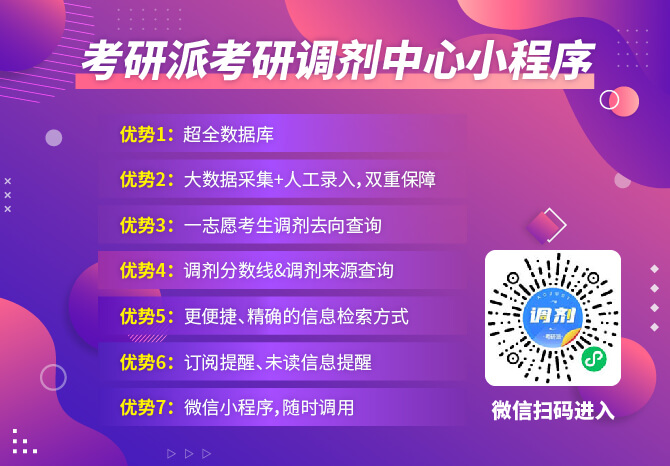China University of Geosciences (Beijing) 70904 Structural Geology Postgraduate Examination Adjustment Report Text
The following contents are sorted out by the [Graduate School Entrance Examination Adjunct Center]. The latest reallocation information, reallocation score, reallocation destination source and other information can be searched by WeChat for the "Graduate School Entrance Examination Adjunct Center" applet.
Professional situation:
China University of Geosciences (Beijing) Department name: Academy of Science Major code and name: 70904 Structural Geology Learning mode: full-time Source of adjustment over the years:
Source of transferred students (statistics from a volunteer college): 3 from the Chinese Academy of Geological Sciences, 1 from Nanjing University, 1 from Peking University, year of transfer: 2018, number of transferred students: 5, minimum score of transfer: 317, maximum score of transfer: 373, median score of transfer: 341.
1. Name of volunteer college: Chinese Academy of Geological Sciences, adjustment year: 2018, total score of preliminary examination: 373;
1. Name of volunteer college: Nanjing University, adjustment year: 2018, total score of preliminary examination: 372;
1. Name of volunteer college: Peking University, year of adjustment: 2018, total score of preliminary examination: 341;
1. Name of volunteer college: Chinese Academy of Geological Sciences, adjustment year: 2018, total score of preliminary examination: 339;
Name of a volunteer college: Chinese Academy of Geological Sciences, year of adjustment: 2018, total score of preliminary examination: 317.
Source of adjustment over the years:
Source of transfer students (statistics of a volunteer college): Ocean University of China, transfer year: 2019, number of transfer students: 1, minimum score of transfer: 314, maximum score of transfer: 314, median score of transfer: 314.
Name of a volunteer college: Ocean University of China, year of adjustment: 2019, total score of preliminary examination: 314.
Source of adjustment over the years:
Source of transfer students (a volunteer college): 1 person from Nanjing University, transfer year: 2020, number of transfer students: 1 person, minimum score of transfer: 330, maximum score of transfer: 330, and median score of transfer: 330.
1. Name of volunteer college: Nanjing University, adjustment year: 2020, total score of preliminary examination: 330.
Source of adjustment over the years:
Source of transferred students (statistics of a volunteer college): 1 person from University of Chinese Academy of Sciences, year of transfer: 2021, number of transferred students: 1 person, minimum score of transfer: 300, maximum score of transfer: 300, median score of transfer: 300}, 'source': []}]
Re examination score:
Total score: 280, single subject 2: 56, single subject 1: 37, year of adjustment: 2021 Total score: 288, single subject 2: 60, single subject 1: 40, year of adjustment: 2020 Total score: 290, single subject 2: 62, single subject 1: 41, year of adjustment: 2019 Total score: 280, single subject 2: 57, single subject 1: 38, year of adjustment: 2018 Research direction of coordination specialty:
Adjustment year: 2021, adjustment direction: 01 - geotectonics and geodynamics Examination subject: (201) English 1, professional course: (809) comprehensive geology, professional course: (610) advanced mathematics, public course: (101) ideological and political theory Year: 2021, adjustment direction: 02 analytic structural geology Examination subject: (201) English 1, professional course: (809) comprehensive geology, professional course: (610) advanced mathematics, public course: (101) ideological and political theory Bibliography:
Examination outline and bibliography of Advanced Mathematics (610) Examination nature The content of this course is monadic calculus and ordinary differential equation. Pay attention to the examinees' mastery of the basic theories and methods of higher mathematics. The evaluation standard is to enable outstanding undergraduate graduates to reach the level of passing or above. Examination method and time 1. tAnswering method: closed book, written examination n2. tAnswering time: 180 minutes n nAnswering paper structure question type proportion: full score 150 points, blank filled questions and multiple-choice questions about 30%; About 70% of the exam content and requirements (I) Functions, limits, and continuity n Examination content n Concept of functions and properties of functions Compound functions, inverse functions The nature of implicit function and piecewise function basic elementary function and the establishment of the functional relationship of the simple application problem of graphic elementary function Definition of sequence limit and function limit and their nature The left limit and right limit of function The concept of infinitesimal quantity and infinitely large quantity and their relationship The nature of infinitesimal quantity and the four operational limits of infinitesimal quantity The two criteria for the existence of the limit: Monotone Bounded Criterion and Pinch Criterion are two important limit functions. They are continuous concepts. Types of discontinuous points. Continuity of elementary functions. Properties of continuous functions on closed intervals. Examination requirements. n u3000 u30001. Understand the concept of functions, master the representation of functions, be able to perform function symbolic operations, and establish functional relationships for application problems. \Understand the boundedness, monotonicity, periodicity and parity of functions. \N u3000 u30003. Understand the concepts of composite function and piecewise function, inverse function and implicit function. \N u3000 u30004. Master the nature and graphics of basic elementary functions, and understand the concept of elementary functions. \N u3000 u30005. Understand the concept of sequence limit and function limit (including left limit and right limit) and the relationship between the existence of function limit and left and right limits. \N u3000 u30006. Master the nature of limit and four algorithms. \N7. Understand the concept and basic properties of infinitesimal quantity, master the comparison method of infinitesimal quantity, be able to use equivalent infinitesimal quantity to find the limit, and understand the concept of infinitesimal quantity and its relationship with infinitesimal quantity. \N 8. Master the two criteria for the existence of limits, and be able to use them to find limits, and master the method of using two important limits to find limits. \N9. Understand the concept of function continuity (including left continuity and right continuity), and be able to judge the type of function discontinuity. \N10. Understand the properties of continuous functions and the continuity of elementary functions, understand the properties of continuous functions on closed intervals (boundedness, maximum and minimum theorems, intermediate value theorems), and apply these properties. \N (II) Differential calculus of univariate functions n Examination contents n Concept of derivatives and differentials Geometric and physical significance Relationship between derivability and continuity of functions Tangents and normals of plane curves and their equations Derivative derivatives of basic elementary functions and four operations of differential Complex functions, inverse functions Differential method of functions determined by implicit functions and parameter equations High order derivatives Invariant Rolle's theorem, Lagrange's mean value theorem, Cauchy's mean value theorem, Taylor's theorem L 'Hospital's method is used to determine the concavity and convexity of extreme function graph of function monotonicity The graph of inflection point and asymptote function depicts the concept of radius of curvature of the maximum and minimum arc differential curvatures of the function n Test requirements n 1. Understand the concept of derivative and the relationship between derivability and continuity, understand the geometric meaning of derivative, be able to calculate tangent equation and normal equation of plane curve, understand the physical meaning of derivative, and be able to describe some physical quantities with derivative. \N2. Master the four operation rules of derivatives and the derivation rules of composite functions, and master the derivative formula of basic elementary functions. \N3. Understand the concept of higher-order derivatives, and be able to calculate higher-order derivatives of some simple functions. \N4. Be able to calculate the derivatives of piecewise functions, implicit functions, functions determined by parametric equations, and inverse functions. \N u3000 5. Understand the concept of differential and the relationship between derivative and differential, understand the four algorithms of differential and the invariance of the first order differential form, and be able to solve the differential of function. \Understand and be able to use Rolle's theorem, Lagrange mean value theorem and Taylor's theorem, and Cauchy mean value theorem. \N u3000 u30007. Master the method of calculating the indeterminate limit by using the L'Hospital rule. \N u3000 u30008. Understand the concept of extreme value of a function, master the method of judging the monotonicity of a function with derivatives and finding the extreme value of a function, master the method of finding the maximum and minimum value of a function and its application. \N u3000 u30009. Be able to use derivatives to judge the concavity and convexity of function graphs, calculate inflection points and horizontal, vertical and oblique asymptotes of function graphs, and describe function graphs. \Understand the concept of curvature and radius of curvature, and calculate curvature and radius of curvature. \N n (III) Integral calculus of one variable function n Examination content n Concept of original function and indefinite integral Basic properties Basic integral formula Concept and basic properties of definite integral Mean value theorem Function of upper limit of integral and its derivative Newton Leibniz formula Variable replacement integral method and partial integral method Rational function Rational form of trigonometric function and integration of simple irrational function Application of abnormal (generalized) integral definite integral nTest requirements n 1. Understand the concept of original function and indefinite integral, master the nature and basic integral formula of indefinite integral, and master the integration by substitution and integration by parts of indefinite integral. \N 2. Understand the concept of definite integral, master the nature of definite integral and the mean value theorem of definite integral, and master the integration by substitution and integration by parts of definite integral. \N3. Be able to calculate the rational expressions of rational functions, trigonometric functions and the integration of simple irrational functions. \N4. Understand the function of upper limit of integral, be able to calculate its derivative, and master Newton Leibniz formula. \N5. Understand the concept of abnormal integral and be able to calculate abnormal integral. \N6. Master some geometric and physical quantities expressed and calculated by definite integral (area of plane figure, arc length of plane curve, volume of rotating body, area of parallel section as known solid volume, work done by variable force, gravity, pressure) and the average value of function. \N (IV) Ordinary differential equation nTest content nBasic concept of ordinary differential equation Variable separable differential equation Homogeneous differential equation First order linear differential equation Bernoulli equation reducible high-order differential equation Properties and structure theorem of solution of linear differential equation Second order constant coefficient homogeneous linear differential equation Simple second order constant coefficient non-homogeneous linear differential equation Some differential equations Simple application nTest requirements n1. Understand the concepts of differential equation and its order, solution, general solution, initial condition and special solution. \N2, 2. Master the solution of differential equations with separable variables and first-order linear differential equations, and be able to solve homogeneous differential equations and Bernoulli equations. \N3. Be able to solve the following forms of differential equations with the reduced order method: n \N4. Understand the properties of solutions of second-order linear differential equations and the structure theorem of solutions. \N5. Master the solution of second order homogeneous linear differential equation with constant coefficients. \N6. Be able to solve the second order non-homogeneous linear differential equation with constant coefficient whose free term is polynomial, exponential function, sine function, cosine function and their sum and product. \N7. Be able to solve some simple application problems with differential equations. \N Bibliography Higher Mathematics, compiled by Department of Mathematics, Tongji University, Higher Education Press, 7th edition; \N Higher Mathematics Exercises, compiled by Department of Applied Mathematics, Tongji University, Higher Education Press. \N Note 601 Advanced Mathematics. The examination outline of Comprehensive Geology (809) and the nature of the reference book examination This course includes three parts: the material composition system of the earth, the stratigraphic history system, and the structural geology system, emphasizing the organic combination of mineralogy, petrology, geological history, and structural geology. The main contents of the examination include the types, concepts, classifications and research methods of common minerals and rocks that should be mastered, the basic concepts and characteristics of structural geology, stratigraphic contact relations and division and comparison, as well as the shape, occurrence, scale, formation conditions, formation mechanism and combination laws of folds, joints, faults, cleavage and other structures and their evolution history. It emphasizes the summary and training of the basic concepts, basic theories, basic characteristics, and basic research methods of minerals, rocks, geological history, and structures. \Its evaluation standard is to enable outstanding undergraduate graduates to reach the level of passing or above. \N Examination method and time 1 Answering method: closed book, written examination. \N2. Answering time: 180 minutes n Test paper structure question type proportion: full score 150. Basic concepts and basic knowledge account for 30-40%, experiment, practice and comprehensive application account for 20%, and comprehensive analysis and discussion questions and picture reading questions account for 40-50%. Examination content and examination requirements Examination points n1 Mineralogy n Basic mineral concepts, visual identification marks and methods of important rock forming minerals, etc. \N2. Petrology nThe concept, genetic classification, research methods and development status of rocks. \N (1) Sedimentary rock: basic concept and formation of sedimentary rock, primary structure of sedimentary rock, classification, composition, structure and structure of terrigenous clastic rock; The composition, texture, structure and main types of carbonate rocks. \N (2) Magmatic rock: concept of magma and magmatism, basic characteristics of magmatic rock, classification basis, chemical composition, mineral composition, texture and structure, occurrence and facies of magmatic rock. \N (3) Metamorphic rocks: concept, mode and type of metamorphism, basic concept and classification of metamorphic rocks, composition, structure and identification method of common metamorphic rocks. \N3. Stratigraphic historical system nStratigraphic contact relationship types and their formation mechanism, stratigraphic division and correlation methods, rock and chronostratigraphic unit types. \N4. Structural geological system nComponent elements, measurement and representation of occurrence elements of planar and linear structures; The characteristic "V" rule of horizontal and inclined strata; Types, identification marks and tectonic significance of unconformity contact; Bedding and its recognition and orientation; The primary structure is used to determine the top surface and bottom surface of the rock layer. For example: n (1) Folds: basic elements, fold geometry, classification basis, basic types and differentiation methods; The combination pattern and characteristics of folds; Folding formation mechanism, contents and methods of fold research. \N (2) Joints: concept and classification, characteristics of tension joints and shear joints; Joint group and joint system; Staging and matching of joints; The relationship between joints and faults and folds; Joint field observation and research significance. \N (3) Cleavage and lineation: permeable and impermeable structures; Concept, structure and type of cleavage; The relationship between cleavage and large-scale structure and its research significance; Understand the formation mechanism of cleavage. Master the concept of lineation and its main types; Large lineation and small lineation; A-type lineation and b-type lineation and their tectonic kinematic significance. \N (4) Fault: geometric elements and displacement of fault, classification of fault, stratum effect of fault, formation mechanism of fault, fault identification method, direction and nature of fault movement; Observation and study of faults; Master the concepts and basic characteristics of thrust nappe structure, strike slip structure and extension structure; Concept and basic characteristics of ductile shear zone. \N (5) Stereographic projection and its application: basic principles of stereographic projection; How to use Wu's website; Stereographic projection of planar and linear structures. \N Bibliography Comprehensive Geology, edited by Wang Genhou, Wang Trainning and Yu Xinqi, Geological Publishing House, 2017 edition. Remark 612 Comprehensive geology. China University of Geosciences (Beijing)
add to China University of Geosciences (Beijing) Sister WeChat , or WeChat search public account“ Postgraduate Examination School Station ”, follow[ Postgraduate Examination School Station ]WeChat official account, WeChat signal input at the small station of postgraduate entrance examination[ China University of Geosciences (Beijing) postgraduate entrance examination score, China University of Geosciences (Beijing) enrollment ratio, China University of Geosciences (Beijing) postgraduate entrance examination group, China University of Geosciences (Beijing) sister WeChat, China University of Geosciences (Beijing) postgraduate entrance examination questions, China University of Geosciences (Beijing) professional catalog, China University of Geosciences (Beijing) ranking, China University of Geosciences (Beijing) research guarantee, China University of Geosciences (Beijing) public account Graduate enrollment of China University of Geosciences (Beijing) ]You can view the corresponding on your phone Information or resources for postgraduate entrance examination of China University of Geosciences (Beijing) 。
![China University of Geosciences (Beijing) Postgraduate Examination Official Account]()
![Official account of postgraduate entrance examination school station]()

.jpg)
.png)





















/1.png)















































